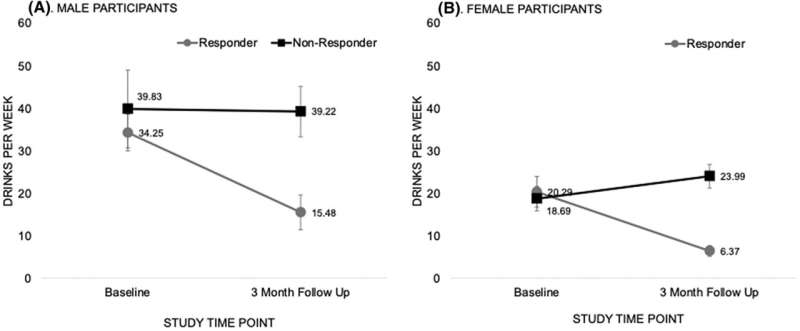This article has been reviewed according to Science X's editorial process and policies. Editors have highlighted the following attributes while ensuring the content's credibility:
fact-checked
peer-reviewed publication
trusted source
proofread
Brain imaging may predict motivation for behavior change in alcohol use disorder

Brain imaging of neuron activity in certain areas of the brain may predict whether an individual is likely to successfully respond to interventions to reduce their drinking.
In a study published in Alcohol: Clinical and Experimental Research, individuals whose baseline imaging showed decreased activity in areas of the brain associated with reward processing and impulsivity and increased activity in regions responsible for complex cognitive processes and emotional regulation were more likely to reduce their drinking following an intervention.
The study examined differences in pre-intervention resting state functional connectivity (rsFC) between people with alcohol use disorder who reduced their alcohol consumption and those who did not. Resting-state functional connectivity is an indirect measure of neuron activity between areas of the brain while the brain is not engaged in specific cognitive, emotional, or other tasks.
Functional Magnetic Resonance Imaging (MRI) showed significant differences in baseline resting state functional connectivity in regions of the brain associated with reward processing, stimulus prioritization, and complex problem-solving in those who responded well to interventions compared to those who did not.
People with alcohol use disorder who reduced their drinking after the intervention also showed decreased activity in the regions associated with impulsivity and alcohol valuation and increased activity in the regions responsible for higher-order cognitive processes and emotional regulation.
The patterns suggest that individuals who responded well to the intervention may have greater internal motivation or less severe disruption to the brain from their alcohol use disorder which may allow them to better engage in the intervention to reduce alcohol use and increase positive behaviors.
The Canadian study conducted functional MRIs on 46 adults with alcohol use disorder aged 21 to 55 immediately followed by a brief, approximately one-hour-long intervention aimed at reducing their alcohol use, with the option of 3 additional visits if participants chose. Three months later, researchers assessed changes in participants' alcohol use.
Both male and female participants who responded to the intervention reduced the amount they drank per week, from 34 drinks per week at baseline to 15 at three months for male participants and 20 drinks per week to six for female participants. For those who did not respond to the intervention, the weekly number of drinks remained relatively flat for men and increased for women from 19 drinks per week at baseline to 24 drinks per week after 3 months.
The authors note that while the resting state functional connectivity patterns identified in the study may contribute to positive health behavior, the analysis is exploratory and further investigation is needed.
More information: Sabrina K. Syan et al, Resting state functional connectivity as a predictor of brief intervention response in adults with alcohol use disorder: A preliminary study, Alcoholism: Clinical and Experimental Research (2023). DOI: 10.1111/acer.15123



















